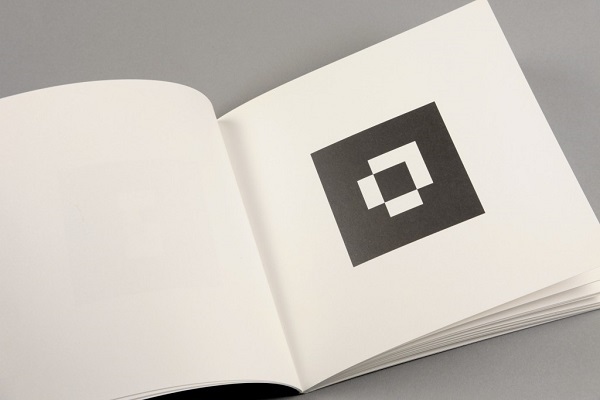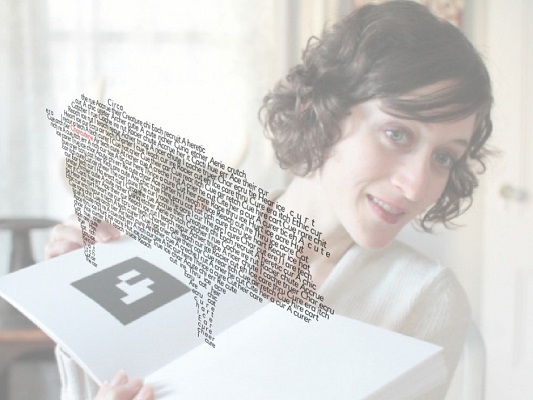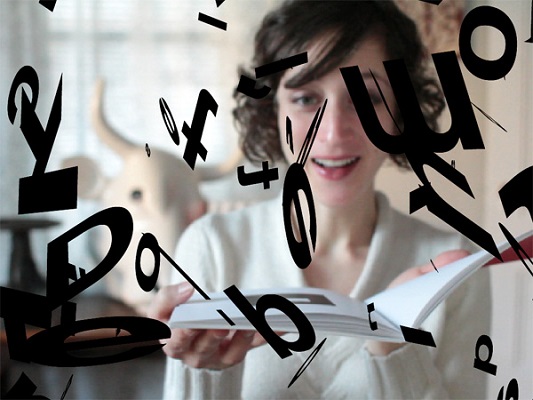Immediate Delay: Temporalizing Aesthetic Experience in Amaranth Borsuk and Brad Bouse's Between Page and Screen
 Monday, June 17, 2019 at 2:20PM
Monday, June 17, 2019 at 2:20PM Ryan Ikeda
[ PDF Version ]
This essay posits aesthetic experience in a digital milieu as matter in time; it blurs the edges of the work of art by considering it a spatiotemporal object. It centers on a work of augmented poetry, Amaranth Borsuk and Brad Bouse’s Between Page and Screen (2012). Methodologically, this essay advances a relational critique of media infrastructures by exploring the temporalizing effects of digital media on aesthetic experience. This essay engages two critical frameworks, disorientation and posthumanism, advanced respectively by noted digital theorists Bernard Steigler and N. Katherine Hayles. I then theorize a third framework, which I call immediate delay. Immediate delay argues that in order to understand the work of art in a digital milieu, critics must understand it as a temporalization of space and a spatialization of time.
A recent trend in New Materialism advances media infrastructures as relational entities. This trend surpasses a naive materialism, which limits critique to the excavation of physical objects or the rendering visible of material structures, by considering how various infrastructures—like data centers—interact with political, economic, and epistemological systems.[1]
Holt and Vondreau articulate a relational position in their essay, “‘Where the Internet Lives’: Data Centers as Cloud Infrastructures,” which situates the data center as a material index to cloud computing. They write, “To understand and explain the many consequences—sociocultural, economic, political, regulatory, and otherwise—of this growing infrastructure gap will require analyses and scholarship that engages with more than material dimensions of infrastructure; indeed, the politics of representation, technology policies, industrial practices, and even the imaginary, abstract constructions of technologized spaces will all be a part of bridging—and visualizing—this gap moving forward.”[2] Holt and Vondreau frame their critique visually. Media infrastructures gain visibility by locating their hardware in a physical setting, but the “growing gap” signifies the space between physical media, an abstract and imaginary space. Holt and Vondreau do not eschew the material substrates completely; their critique tethers the figurative and immaterial aspects of the cloud to the physical data centers for Apple and Google. The physical location of a data center (an object) offers a material index of the cloud (a trope), while the figurative cloud spatializes imaginary space. The gap also exists between data center and cloud, and between the cloud and a public imaginary. A relational critique encompasses both dimensions of the gap—the materialization of the figurative and the spatialization of the imaginary. The relation of material and space to time is absent from their relational critique.When we think of contemporary technology, we generally think in terms of speed—fast Wi-Fi connection, faster processors, quick loading times, software updates, staying up-to-date with the latest device—a state of permanent innovation, according to digital media theorist Bernard Stiegler. It is not enough that new products constantly emerge; when they arrive, the devices must be more efficient than earlier versions. Consider binge-watching and streaming services, both organized around the immediate consumption of content. As consumers, the idea of waiting for the weekly delivery of a serialized TV show feels anachronistic. It is a delay that frustrates.
The tension between delay and immediacy has everything to do with imagination. The premise of an avant-garde, for example, positions human artists at the edge of cultural production, leading the charge toward new fields of aesthetic possibility. Yet digital technology operates at the speed of light; no human can move faster. The prospect of an avant-garde introduces a problem of primacy, which we might consider a spatiotemporal problem: in a digital milieu, the position of an avant-garde emerges within technology. Such a distinction does not necessarily relegate imagination to the background, but it does reticulate its practices. Rather than operating at the edge of culture, avant-garde now functions from the center. In a recent essay on digital poetics, Joseph Tabbai repeatedly insists that there is no place for an avant-garde within the digital. Tabbai describes how proprietary software, such as Microsoft Word and Adobe PDF, normalize and instrumentalize experimentation at the level of procedure. [3] Poets and artists working within a digital medium are complicit in its reification; their lack of critical awareness signals the totalizing effect of immediacy to flatten distinctions between art, avant-garde art, and digital tools. Tabbai’s claim that the digital forecloses a possibility for the existence of avant-garde practices is epistemic. Like the quaint adage suggests, “Fish were not the first to discover water”; humans are so accustomed to its temporalizing effect (i.e., adrift in it) that they are unable to perceive the prepositional inaccuracy entailed by the term avant-garde. While denying the avant-garde a place on the “edge” of cultural production, Tabbai’s critique draws attention to a different category of edgework involved in contemporary poetics: the boundary between temporalized experience and spatialized experience, or the way immediacy temporalizes aesthetic experience of one’s physical setting.
Consider how Between Page and Screen, a collaborative work of augmented poetry by Amaranth Borsuk and Brad Bouse, situates poetry as a relational encounter at the edge of a page, screen, scanner, and (human) reader. While Between is a physical book, it requires a laptop camera to read. It features an untitled black-and-white glyph on each page; there are no recognizable poems legible in the book itself. To locate its poetry, a (human) reader must open Between and turn a page until its glyph faces the laptop camera. Then, a QR scanner embedded in the camera can reveal a poem on the computer screen. As each glyph faces the camera, a new poem emerges on screen—each poem is only available as long as its glyph faces the scanner. Poems also rotate, shrink, expand, and gain and lose focus depending upon the distance and angle by which a reader positions each glyph in front of the camera. The camera has two functions, however: in addition to scanning glyphs, it captures the reader’s body as it holds the book. Simultaneously, the camera digitizes the reader’s body and materializes its semblance on screen behind the poem. The poem thus gains its visibility between a reader and their digital representation.

Figure 1. Amaranth Borsuk and Brad Bouse, Between Page and Screen, 2012.
By hiding its poems within computer code, Between imitates the transition of avant-garde poetics from edgework to network. Like Tabbai’s critique, Between emphasizes the reticulated position of poet, poem, and poetry within a network. Unlike Tabbai’s insistence on instrumentality and normalization, Borsuk and Bouse describe the creative and the digital as coextensive: the poem emerges somewhere between the technical and the human. As a preposition, “between” expands the new materialist relational critique that centers poetics at the edge of space and time. The poem is irreducible to its material substrates; it cannot be found exclusively in its code, electrical current, screen, page, or reader. It gains visibility through a temporal sequence that orders a set of material objects. Between situates the poem within, as, and as constituted by this dynamic process.

Figure 2. Borsuk and Bouse, Between Page and Screen, 2012.
Between obfuscates the physical location of the poem because it locates the poem relationally and not materially, as matter in time. That is, Between’s poem exceeds the material dimensions of code, page, book, aperture, and screen; it cannot be reduced to or found within one of these material substrates. Instead, the poem presented by Borsuk and Bouse is a dynamic, metastable process—an enduring potential becoming that gains material visibility within, through, and between a set and sequence of interactions. The poem traffics at the edge of solidity, less object than process. The edge is permeable rather than solid. It is from this spatiotemporal fringe position that their poem gains its materiality and visibility.
Their title enacts this collision of space and time, too. As a preposition, between can indicate either a position in space or a position in time. Its indeterminacy signals the absence of a hard edge; it introduces an ambiguity that necessarily imbricates time to space and space to time. The act of reading Between becomes a complicated and relational process that softens the edges among multiple systems: print and digital technologies, interpretative and algorithmic frameworks, human appendages and nonhuman technical devices. Poems emerge coextensively; they are irreducible to a material substrate, and irreducible to categories of technical or human.

Figure 3. Borsuk and Bouse, Between Page and Screen, 2012.
Another way to approach the interplay of time and space in Between is as a poetics of the glitch. [4] Like an error, a glitch usually refers to the stoppage of time, when a technical device stops working properly. The effect is both jarring and frustrating because users must stop what they are doing to identify and fix the problem to resume the desired activity. The glitch not only interrupts the user’s sense of time but also functions allegorically by gesturing to another temporality outside the device. Between glitches reader expectation of book time (analog) by introjecting a camera and screen (digital). It describes this expectation as a habituation or preference toward the temporalizing effects book technology has on its reader. For Tabbai, the glitch is revelatory, disclosing the hard edges surrounding between. He writes of the digital, “As the mechanisms become more and more hidden, our attention today turns more to errors, liminalities, and glitches.” [5] This turn toward error, liminality, and glitch is a turn away from spatialization toward the temporalization of materials and material experience. More specifically, it is a turn toward theorizing the work of art as a matter of digital time.
Stiegler describes this fascination with immediacy through what he calls a “problem of disorientation.” For Stiegler, this problem emerges—and accelerates—in the wake of the Industrial Revolution, where the speed of technical development outpaces social organization. The social seemingly lags behind innovation, unsuccessfully attempting to catch up.[6] This endeavor of lagging to catch up approaches an impossible task in a given milieu. While earlier avant-gardes might have been able to step outside of the spatialization of a typewriter’s temporality by organizing poems that unsettle its left-justified, top-down default, the immediacy of digital time outpaces, and reticulates, all activity. Aesthetic experience occurs within the digital; there is an absence of the edge because there are only networked infrastructures. Like the glitch, disorientation is allegorical. It introjects an alternative temporality while immersed within another. The introjecting time, be it biotic, physical, or something altogether different, creates an edge between its temporalizing effect on human experience and the temporalization of the digital.
Stiegler’s disorientation signifies a stoppage of time in an allegorical sense. But instead of simply delaying human activity like an error or a glitch, disorientation intensifies the temporal experience of immediacy and works to constitute subjectivity through the creative act. He writes, “The static oppositions of Western metaphysics must be replaced by dynamic compositions: one must think in terms, not of hierarchies or totalizing systems, but of processes.” [7] For Stiegler, technics constitute the human just as the human constitutes technology; their coextension intensifies their edges. However, Stiegler’s vested interests reside in the mechanisms and processes involved in “dynamic compositions.” Like Holt and Vondreau’s relational critique of infrastructure, Stiegler posits the human as irreducible to its material, biotic system and attributes its excess, what he calls the “epiphylogenetic,” to the temporalizing effects of technology. Each domain concretizes its spatial experience through a recognition of their differing, yet permeable, temporalities.
N. Katherine Hayles offers an interesting counterpoint to Stiegler’s disorientation. Like Stiegler, she recognizes an imbrication of human and technical device, but for Hayles their imbrication emerges at the advent of digital technology and concretizes into a figure she calls posthuman. Here, we might consider the posthuman as both a flattening and accentuating of the human and the technical through an unspecified process. Unlike Stiegler, Hayles’s interest lies in categorical edgework that isolates eras (Enlightenment and digital) and identities (human and nonhuman). The prefix post-signifies the next iteration of the human species that is still part of the human category. Thus, the posthuman may connote an apocalyptic end to humans, but her argument is more precisely interested in preserving what is categorically human.
To make her case, Hayles draws a hard edge between pre-digital metaphors (e.g., self-reliant, self-determined, liberal, etc.), which entered the public intellectual sphere during the Enlightenment, and human experience in a digital milieu. Unlike Stiegler, her posthuman project stays within the human domain. It locates the posthuman as an object before interrogating or explicating its individuation (i.e., Stiegler’s “dynamic compositions”). Hayles observes the effects of digital (as strictly digital) on the human body and how it distributes and outsources human sensation through technical devices.
One might consider how the title of her 1999 book, How We Became Posthuman, marks the posthuman as a temporalized object, a categorical fact, and an already-formed being. Whereas disorientation evokes a process, an enduring set of temporal disruptions that constitutes human experience, the posthuman is the ossification of digital time; it is the materialization of immediacy. In Posthuman, Hayles identifies distributed cognition as a structural condition necessary for a posthuman turn; rather than attend to processual elements here, her interest is strictly in material embodiment.[8] Her observation is retrospective; it comments on the material object (the posthuman) and its solidification.
To elaborate, Hayles engages Turing’s imitation game and the more recent Moravec Test to demonstrate how human cognition has left the human bios and moved into a new physical location. Hayles writes, “The important intervention comes much earlier, when the test[s] put you into a cybernetic circuit that splices your will, desire, and perception into a distributed cognitive system in which represented bodies are joined with enacted bodies through mutating and flexible machine interfaces. As you gaze at the flickering signifiers scrolling down the computer screens, no matter what identifications you assign to the embodied entities that you cannot see, you have already become posthuman.”[9] You have already become posthuman. Verb tense is important here because it signifies a telic determinism encoded in information control (i.e., cybernetics). She introduces a complex temporal play in contradistinction to, but not unlike, Stiegler’s disorientation. Hayles’s posthuman embodies and solidifies immediacy, which gains visibility in retrospect.[10] The act of gazing “at the flickering signifiers” does not constitute subjectivity. Like Stiegler suggests, it reveals subjectivity as already reticulated and perception as already instrumentalized to the tempo of the “machine interface.”
Disorientation and the posthuman both posit that digital technology constitutes human experience, but disorientation approaches its effect through time (through immediacy) while the posthuman observes its effect in space (through the distributed cognition of the human body). The difficulty in situating these concepts first together and then, again, in relationship to aesthetic experience is that each affirms and erases various edges between time and space. By tethering disorientation to the posthuman and the posthuman to disorientation, it is possible to confront the ossification of immediacy into delay and also the individuation of delay into immediacy, an approach I describe as immediate delay. Immediate delay seeks to explore materiality as time and space, as space in time, and as time as space, among myriad techno-human imbrications that avail themselves for critique in a digital milieu. Like Borsuk and Bouse’s work of augmented poetry, aesthetic experience has been reticulated and is thusly always already relational. What distinguishes poetry in a digital milieu, then, is not an advanced cultural position, but rather, its ability to clarify and transgress the edges among and within spatiotemporal signatures of network infrastructures.
Notes
[1] Jennifer Holt and Patrick Vondreau, “‘Where the Internet Lives’: Data Centers as Cloud Infrastructures,” in Signal Traffic: Critical Studies of Media Infrastructure, ed. Lisa Parks and Nicole Starosielski (Champaign: University of Illinois Press, 2015), 79–80.
[2] Ibid., 88.
[3] Joseph Tabbai, introduction to The Bloomsbury Handbook of Electronic Literature, ed. Joseph Tabbai (London: Bloomsbury Academic, 2018), 1–11.
[4] Nathan Jones, “Glitch Poetics: The Posthumanities of Error,” in The Bloomsbury Handbook of Electronic Literature, ed. Joseph Tabbai (London: Bloomsbury Academic, 2018), 237–53.
[5] Tabbai, introduction, 1–11.
[6] Bernard Stiegler, Technics and Time, vol. 2: Disorientation, trans. Stephen Barker (Stanford, CA: Stanford University Press, 2009).
[7] Ibid., 2.
[8] Hayles’s most recent research centers on intermediation, cognitive assemblages, and bio-techno semiotics—sets of dynamic compositions that imbricate human and nonhuman domains, blurring the categorical boundaries between the two.
[9] N. Katherine Hayles, How We Became Posthuman: Virtual Bodies in Cybernetics, Literature, and Informatics (Chicago: The University of Chicago Press, 1999).
[10] Simondon describes the individual as a temporal confusion: scholars locate the individual as prior to its individuation when in fact the inverse is true: individuation produces the individual. This describes another way to examine Stiegler and Hayles: the latter approaches the temporal through individuation, while the former through the individual. See Gilbert Simondon, “The Problem of the Position of Ontogenesis,” trans. Gregory Flanders, Parrhesia 7 (2009): 4–16.
Ryan Ikeda is a doctoral candidate in the Department of Rhetoric at University of California, Berkeley, where he studies poetics and all things digital. He writes poetry, sometimes.
Reader Comments